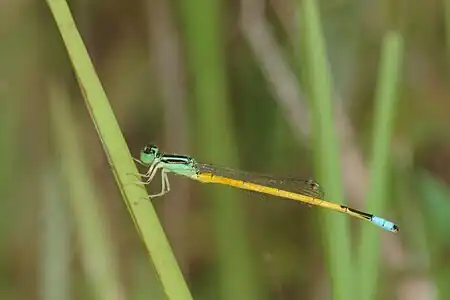| Western golden dartlet | |
|---|---|
 | |
| male | |
 | |
| female | |
| Scientific classification | |
| Domain: | Eukaryota |
| Kingdom: | Animalia |
| Phylum: | Arthropoda |
| Class: | Insecta |
| Order: | Odonata |
| Suborder: | Zygoptera |
| Family: | Coenagrionidae |
| Genus: | Ischnura |
| Species: | I. rubilio |
| Binomial name | |
| Ischnura rubilio Selys, 1876 | |
| Synonyms | |
| |
Ischnura rubilio,[1] western golden dartlet,[2] is a species of damselfly in the family Coenagrionidae.[2] It is found in Indian subcontinent and Iran.[3]
Earlier it was considered as a subspecies of Ischnura aurora, distributed from Australia and Pacific Islands.[4] There are strong differences in DNA between the Asian forms of the species and specimens from the Pacific.[4] There is also some morphological differences; dorsal side of segment 8 and 9 are entirely blue in Asian forms compared to only 1/3 of length of segment 8 is blue in specimens from the Pacific.[5] The form found in Indian subcontinent and Iran is Ischnura aurora rubilio Selys, 1876 and is now considered as a good species, Ischnura rubilio.[3]
Description and habitat
It is a small apple green damselfly with black thoracic stripes, black capped olive green eyes, and blue tipped yellow tail. Its thorax is bronzed black color on dorsal side with narrow olive green antehumeral stripes. The lateral sides of the thorax is also pale olive green. The wing spots are different in fore and hind-wings. It is rose-red for its proximal half and transparent for the distal. Its abdomen is rusty-yellow, except for segments 8 to 10, which are azure blue. There is a large diamond-shaped spot on apical end of the dorsum side of segment 6. Segment 7 is broadly bronzed black on the dorsum. Segments 8 to 10 entirely azure blue. There is a broad black dorsal spot in segment 10. Anal appendages are pale brown, tipped with black. Female is more robust and less conspicuously marked than the male. Its abdomen is marked with a broad black dorsal stripe extending the whole length. The sides of the abdomen is yellowish red.[6]
See also
References
- ↑ "World Odonata List". Slater Museum of Natural History. Retrieved 2017-03-03.
- 1 2 3 "Ischnura rubilio Selys, 1876 – Western Golden Dartlet". Odonata of India, v. 1.00. Indian Foundation for Butterflies. Retrieved 2017-03-03.
- 1 2 Dumont, H. J. (December 2013). "Phylogeny of the genus Ischnura, with emphasis on the Old World taxa (Zygoptera: Coenagrionidae)" (PDF). Odonatologica. 42 (4): 301–308.
- 1 2 Dow, R.A.; Rowe, R.; Marinov, M. (2013). "Ischnura aurora". IUCN Red List of Threatened Species. 2013: e.T167375A1177456. doi:10.2305/IUCN.UK.2013-1.RLTS.T167375A1177456.en.
- ↑ Rj, Rowe (2010-08-13). "Ischnura aurora (Brauer 1865) (Zygoptera: Coenagrionidae), an Australo-Pacific species". New Zealand Journal of Zoology. 37, 2010 - Issue 2 (2): 189–192. doi:10.1080/03014223.2010.488789.
- 1 2 C FC Lt. Fraser (1933). The Fauna of British India, including Ceylon and Burma, Odonata Vol. I. Red Lion Court, Fleet Street, London: Taylor and Francis. pp. 360–362.
- ↑ C FC Lt. Fraser (1924). A Survey of the Odonate (Dragonfly) Fauna of Western India and Descriptions of Thirty New Species (PDF). pp. 492–489.
- ↑ Subramanian, K. A. (2005). Dragonflies and Damselflies of Peninsular India - A Field Guide.
External links
 Data related to Ischnura rubilio at Wikispecies
Data related to Ischnura rubilio at Wikispecies Media related to Ischnura rubilio at Wikimedia Commons
Media related to Ischnura rubilio at Wikimedia Commons